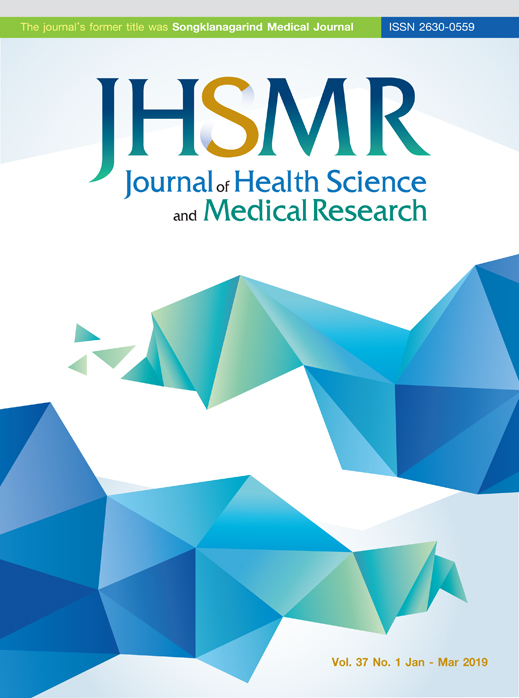P-cadherin and CD10 Expression to Distinguish between Ductal Carcinoma in Situ and Invasive Ductal Carcinoma of the Breast
DOI:
https://doi.org/10.31584/jhsmr.201936Keywords:
CD10, ductal carcinoma in situ, invasive ductal carcinoma, myoepithelial cell, P-cadherinAbstract
Objective: To use placental cadherin (P-cadherin) and cluster of differentiation 10 (CD10) immunohisto chemical staining, to separate ductal carcinoma in situ (DCIS) from invasive ductal carcinoma (IDC).
Material and Methods: DCIS (n=48), equivocal (n=18), and IDC grade 1 (n=17) cases were evaluated by using immunohisto chemical staining, with P-cadherin and CD10 for identifying the myoepithelial cells.
Results: P-cadherin is positive in myoepithelial cells in almost all cases of DCIS (79.0%), and equivocal groups (61.0%). CD10 also shows a positive result in most cases of DCIS (98.0%) along with equivocal groups (72.0%). Both, P-cadherin and CD10 are negative in all cases of IDC grade 1. P-cadherin shows a high percentage of positivity in luminal cell in DCIS (83.0%), equivocal group (100.0%) and IDC grade 1 (88.0%). CD10 shows a low positive in the luminal cell of most cases of DCIS (13.0%), equivocal group (6.0%) and IDC grade 1 (0.0%). CD10 is positive in myofibroblastic cells in approximately 30.0% of all cases, but P-cadherin shows all negative staining.
Conclusion: P-cadherin and CD10 show high sensitivity for detecting the myoepithelial cells, but P-cadherin has a lower specificity, due to it having more luminal cells expression. Therefore, P-cadherin may be helpful for diagnosis in some cases that have a high expression of CD10 in myofibroblastic cells.
References
2. Lester SC. The breast. In: Kumar V, Abbas AK, Aster JC, editors. Robbin and Cotran pathologic basis of disease. 9th ed. Philadelphia: Elsevier Saunders; 2014;p.1043-71.
3. Ellis IO, Cornelisse CJ, Schnitt SJ, Sasco AJ, Sastre-Garau X, Kaaks R, et al. Invasive breast carcinoma. In: Tavassoli
FA, Devilee P, editors. Pathology and genetics of tumors of the breast and female genital organs. Lyon: IARC Press; 2003;p.13-23.
4. National Cancer Institute at the National Institutes of Health. Breast Cancer Treatment (PDQ®): treatment options for ductal carcinoma in situ [homepage on the Internet]. Bethesda: NCI; 2014 [cited 2014 Jul 20]. Available from: http://www.cancer.gov/cancertopics/pdq/treatment/breast/Patient/page6
5. National Cancer Institute at the National Institutes of Health. Breast Cancer Treatment (PDQ®): treatment options by stage [homepage on the Internet]. Bethesda: NCI; 2014 [cited 2014 Jul 20]. Available from: http://www.cancer.gov/cancertopics/pdq/treatment/breast/Patient/page8
6. Lerwill MF. Current practical applications of diagnostic immunohistochemistry in breast pathology. Am J Surg Pathol
2004;28:1076–91.
7. Hicks DG. Immunohistochemistry in the diagnostic evaluation of breast lesions. Appl Immunohistochem Mol Morphol 2011;19:501–5.
8. Mukai K, Iwaya K. CD10 expression in normal breast and breast cancer tissues. In: Hayat MA, editor. Handbook of
immunohistochemistry and in situ hybridization of human varcinomas; molecular genetics; lung and breast carcinomas.
Burlington: Elsevier; 2004;p.299-305.
9. Moritani S, Kushima R, Sugihara H, Bamba M, Kobayashi TK, Hattori T. Availability of CD10 immunohistochemistry as a marker of breast myoepithelial cells on paraffin sections. Mod Pathol 2002;15:397–405.
10. Kalof AN, Tam D, Beatty B, Cooper K. Immunostaining patterns of myoepithelial cells in breast lesions: a comparison of CD10 and smooth muscle myosin heavy chain. J Clin Pathol 2004;57:625–9.
11. Paredes J, Correia AL, Ribeiro AS, Albergaria A, Milanezi F, Schmitt FC. P-cadherin expression in breast cancer: a review. Breast Cancer Res 2007;9:214.
12. Albergaria A, Ribeiro AS, Vieira AF. P-cadherin role in normal breast development and cancer. Int J Dev Biol 2011;55:811–22.
13. Han AC. Role of cadherins in breast cancer. In: Hayat MA, editor. Handbook of immunohistochemistry and in situ hybridization of human carcinomas, volume 1 molecular genetics; lung and breast carcinomas. Burlington: Elsevier; 2004; p.343-9
14. Peralta SA, Knudsen KA, Salazar H, Han AC, Keshgegian AA. P-cadherin expression in breast carcinoma indicates
poor survival. Cancer 1999;86:1263–72.
15. Paredes J, Milanezi F, Viegas L, Amendoeira I, Schmitt F. P-cadherin expression is associated with high-grade ductal
carcinoma in situ of the breast. Virchows Arch 2002;440:16–21.
16. Liu N, Yu Q, Liu TJ, Gebreamlak EP, Wang SL, Zhang RJ, et al. P-cadherin expression and basal-like subtype in breast cancers. Med Oncol 2012;29:2606–12.
17. Gamallo C, Moreno-Bueno G, Sarrió D, Calero F, Hardisson D, Palacios J. The prognostic significance of P-cadherin in infiltrating ductal breast carcinoma. Mod Pathol 2001;14:650–4.
18. Turashvili G, McKinney SE, Goktepe O, Leung SC, Huntsman DG, Gelmon KA, et al. P-cadherin expression as a prognostic biomarker in a 3,992 case tissue microarray series of breast cancer. Mod Pathol 2011;24:64–81.
19. Kovacs A, Walker R. P-cadherin as a marker in the differential diagnosis of breast lesions. J Clin Pathol 2003;56:139–41.
20. Bhatia Y. P-cadherin as myoepithelial cell marker for differential diagnosis of benign and malignant breast lesions.
Indian J Pathol Microbiol 2013;56:6–9.
21. Palacios J, Benito N, Pizarro A, Suarez A, Espada J, Cano A. Anomalous expression of P-Cadherin in breast carcinoma correlation with E-cadherin expression and pathological features. Am J Surg Pathol 1995;146:605–12.























